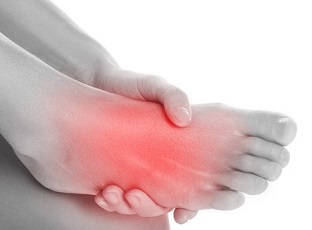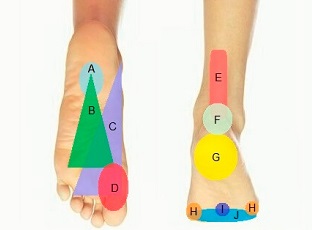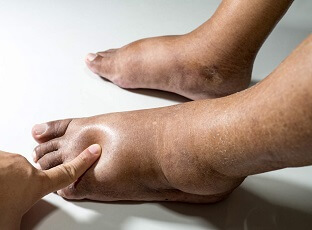- Home
- Diagnosis Guide
- Foot Lumps
- Lump On Top Of Foot
Lump On Top Of Foot
Written By: Chloe Wilson BSc(Hons) Physiotherapy
Reviewed By: FPE Medical Review Board
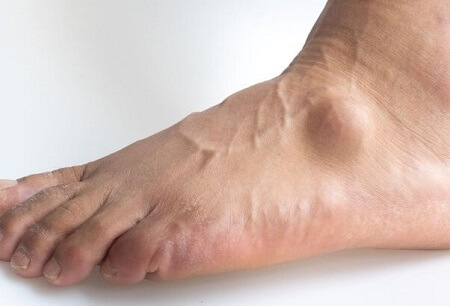
A lump on top of the foot is a common problem which can affect people at any age.
The foot lump may be hard or soft, painful or painless, small or large and may have developed suddenly or gradually.
Swelling may have developed as a result of an injury or the bump may have appeared due to an underlying foot condition.
In most cases, a bump on top of the foot is nothing to worry about but any new growth should be examined by your doctor to rule out any serious conditions.
Here we will look at the common causes of a lump in the top of the foot, how they present, why they develop and how to treat them.
What Causes A Top Of Foot Lump?
A lump on top of the foot, aka dorsal foot mass, is usually caused by:
- Benign Growths: ganglion cyst, lipoma, sebaceous cyst
- Bone Damage: bone spurs, fractures, bunions
- Arthritis: Gout, osteoarthritis, rheumatoid arthritis
- Inflammation: tendonitis, bursitis
Let’s have a look at each of these causes of a bump on top of the foot.
1. Foot Cysts
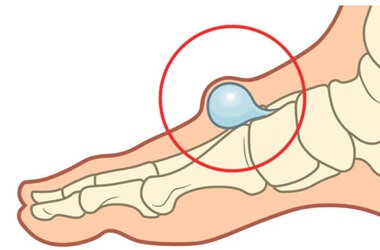
The most common cause of a lump on top of the foot is a cyst. Top foot cysts are non-cancerous (benign) lumps, typically round or oval-shaped that are filled with thick, clear, jelly-like fluid.
There are two types of cyst that can cause a lump on top of the foot:
- Ganglion Cyst: a sac of thick fluid that forms a soft lump along the top of the foot, usually near one of the tendons or joints, just underneath the skin. A ganglion usually forms a small, pea-sized lump on top of the foot but the lump can grow to the size of a golf ball.
- Digital Mucous Cyst: a small pocket of fluid that typically forms a lump on top of the toes. A lump on top of the foot from a mucous cyst is typically less than 1cm wide.
Mucus cysts and ganglion cysts are very similar and look and feel like smooth, spongy bumps on top of the foot or toes. The main difference is where they occur. Ganglion cysts can cause a lump anywhere on top of the foot whereas mucous cyst lumps tend to develop on top of the toes, particularly around the nail.
Digital mucous cysts and ganglion foot lumps are both completely harmless and are usually painless unless they press on one of the foot nerves, which can lead to a burning pain or tingling and numbness. If the cyst is located near one of the joints in the foot it can interfere with ankle, foot or toe movement.
Ganglion cysts are the most common cause of a soft lump on top of the foot, typically occur between the ages of 20-40 and are more common in women than men. Digital mucous cysts are more common in people over the age of 50.
A ganglion lump or cyst on top of the foot that isn’t causing any pain or stiffness does not require any treatment, but if it starts causing problems then your doctor may decide to drain the fluid (aspiration) or surgically remove the cyst (excision).
2. Bone Spurs
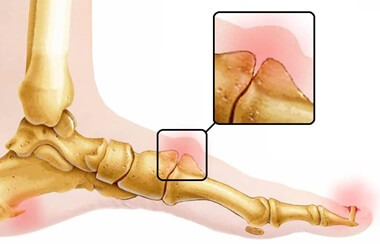
The most common cause of a hard lump on top of the foot is a bone spur.
Bone spurs occur when small bony growths, known as osteophytes, form on or between the foot bones resulting in a bone bump.
A bone spur on top of the foot may be caused by:
- Damage: to one of the bones or joints in the foot from an injury, wear and tear or inflammation can result in a hard bump on top of foot. The most common cause here is osteoarthritis.
- Repetitive Pressure: through the bone or joint e.g. from altered foot biomechanics, over-training or wearing ill-fitting shoes
- Excessive Friction: on the bone e.g. muscle tightness will result in tension where the tendon attaches to the bone which pulls on the bone causing excess bone growth
Two common types of bone spurs that cause a lump on top of the foot are:
- Metatarsal Exostosis: Bone spurs on one of the metatarsal foot bones
- Metatarsocuneiform Exostosis: bone spurs that forms between the big toe and second toe bones
A bone bump on top of the foot is not normally painful unless it is associated with arthritis, but a bone spur often becomes uncomfortable if it rubs on footwear.
3. Gout Foot
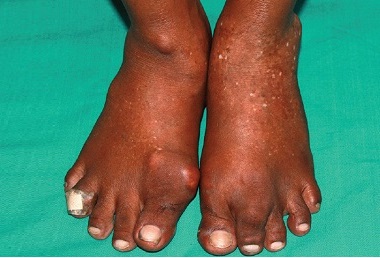
Another common cause of a lump on top of the foot, particularly around the big toe, is gout.
A foot lump from gout is caused by a build-up of uric acid crystals in one of the joints, most typically the big toe.
If your big toe is swollen, red, painful and hot, chances are your foot bump is due to gout.
Gout is more common in men than women and has been linked with certain medical conditions (e.g. diabetes and high blood pressure), diet, obesity and genetics.
If your doctor suspects the lump on top of your foot is due to gout, they may order blood tests or take a sample of fluid from the lump to test for uric acid crystals.
Find out more about the causes, symptoms and how to treat a gout lump on top of your foot in the Foot Gout section.
4. Lipoma
A bump on top of the foot may be caused by a lipoma – a soft, fatty lump that grows under the skin. A top of foot bump caused by a lipoma is typically:
- Small: and slow growing
- Slightly Mobile: moves a little when you press on it
- Soft: and squishy
- Painless
A lipoma lump on top of the foot is completely harmless and is not cancerous. In most cases a lipoma foot lump does not require treatment, although they can be surgically removed if they become particularly large.
5. Fractures
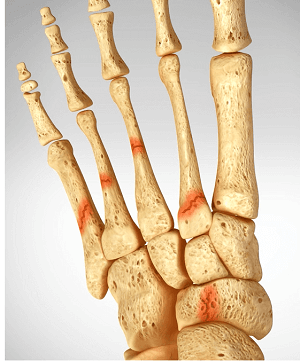
A hard, painful lump on top of the foot can be due a break in one of the foot bones from a:
- Fracture: a sudden break in the bone due to an injury e.g. direct impact, twisting or a fall. If the bone is displaced, it may stick out slightly causing a visible, painful lump on top of foot.
- Stress Fracture: a small, hair-line break in one of the foot bones from repetitive over-loading e.g. suddenly increasing training levels. There may be swelling and a small bump on top of the foot over the injured area.
If you have a hard, painful lump on top of your foot that developed after an injury, or you are have recently taken up a new sport or increased your activity levels, your doctor should send you for an x-ray to check for fractures.
Treatment for a bone bump on top of the foot will depend on the type, severity and location of the foot fracture and may involve wearing a specially designed splint, boot or shoe to protect the foot and take pressure off the top of foot bump.
If you think the lump on top of your foot is from a fracture, check out the foot stress fractures section to find out more about the causes, symptoms, diagnosis and best treatment options.
6. Bunions
A hard lump on top of the foot around the big toe or little toe may be from a bunion, a common cause of toe deformity.
The classic presentation of a bunion is large bone bump on the top and side of the foot that is swollen, red and painful, and pushes the big toe inwards. A bunion lump on top of the foot at the big toe is known as Hallux Abducto Valgus, and at the little toe is known as a bunionette or tailors bunion.
A big toe lump on top of the foot from a bunion is usually caused by wearing tight, pointed shoes, particularly ones with high heels.
There are a number of treatment options for bunion bone lumps which are more effective the earlier they are treated, otherwise surgery may be necessary.
You can find out more about the causes, symptoms and treatment options in the Foot Bunions section.
Rare Causes Of A Top Of Foot Bump
There are a few other, less common possible causes of a lump on top of the foot:
- Bursitis: inflammation of one of the small fluid filled sac that sit between bones and soft tissues to reduce friction. The most common place to get foot bursitis is the back of the heel
- Hallux Rigidus: a type of degenerative arthritis in the big toe. Hallux rigidus causes, pain, stiffness and swelling around the big toe
- Tendonitis: Inflammation of the foot tendons can result in a bump on top of the foot. Foot tendonitis typically causes a sharp, burning pain that is worse with initial movement or after lots of activity
- Accessory Navicular: a small extra bone that sits at the top of the inner foot arch, found in approximately 10% of the popluation. Causes pain and swelling when irritated known as accessory navicular syndrome
- Rheumatoid Nodules: If you have rheumatoid arthritis, the lump on top of your foot is most likely a rheumatoid nodule. They are hard, round foot bumps that form underneath the skin and may rub on your shoes or cause pain when walking
- Sebaceous Cyst: a slow growing, fluid-filled lump just under the skin due to blocked or damaged sebaceous glands or hair follicles
- Corns/Calluses: Thick, raised, hardened areas of skin around the foot may be corns or calluses
- Cancer Lump On Foot: Most foot tumors are benign (non-cancerous) but occasionally a lump on top of the foot may be malignant (cancerous). Signs to watch for are large lump (over 5cm) that keeps growing and becomes increasing painful. A cancerous lump is usually immobile and irregularly shaped but not always.
Any lump on top of the foot should be checked out by your doctor so they can accurately diagnose the underlying problem and ensure you get the right treatment.
#CommissionEarned from Amazon on qualifying purchases
Treating A Bump On Top Of Foot
Treatment for a lump on top of your foot will depend on the underlying cause of the bump but will typically include:
- Pain Relief: over-the-counter pain medications e.g. paracetamol and/or NSAID’s e.g. ibuprofen are usually sufficient – check with your doctor or pharmacist before taking any medication
- Swelling Relief: Regularly applying ice, keeping the foot elevated and wearing tubigrip can help to reduce foot swelling
- Activity Relief: Changing your footwear to wider, softer shoes can really help and some people benefit from wearing orthotics to correct abnormal foot position. Both of these can help to reduce the pressure through your bump on top of the foot
- Exercises: Strengthening and stretching exercises can reduce pressure and improve support through the foot
- Surgery: In some cases, a lump on top of foot may need to be drained or removed surgically. This is only usually indicated if the top of foot lump is causing worsening symptoms despite other treatments or if there is a bone bump on top of foot that needs removing
Lump On Top Of Foot Summary
In most cases, a lump on top of the foot is nothing to worry, but any new growth should always be reviewed by your doctor. Common causes include a bone spur on top of the foot or a ganglion cyst. If pain is more of a problem than the lump itself, check out the Pain On Top Of Foot article.
A soft lump on top of the foot is usually a ganglion cyst or lipoma.
A hard lump on top of the foot may be due to a bone spur or stress fracture.
A lump on top of the toes may be from gout (typically red and warm) a digital mucous cyst (often by the nail) or bunions.
If you have lumps or bumps anywhere else on you foot, check out the Foot Lump & Bumps article for help working out what is going on or choose from the following articles:
In most cases a bump on top of the foot won’t cause any pain and therefore requires minimal treatment. However, if symptoms worsen then a combination of medication, orthotics, exercises and occasionally surgery can help.
Related Articles
Page Last Updated: 24th April, 2025
Next Review Due: 24th April, 2027
